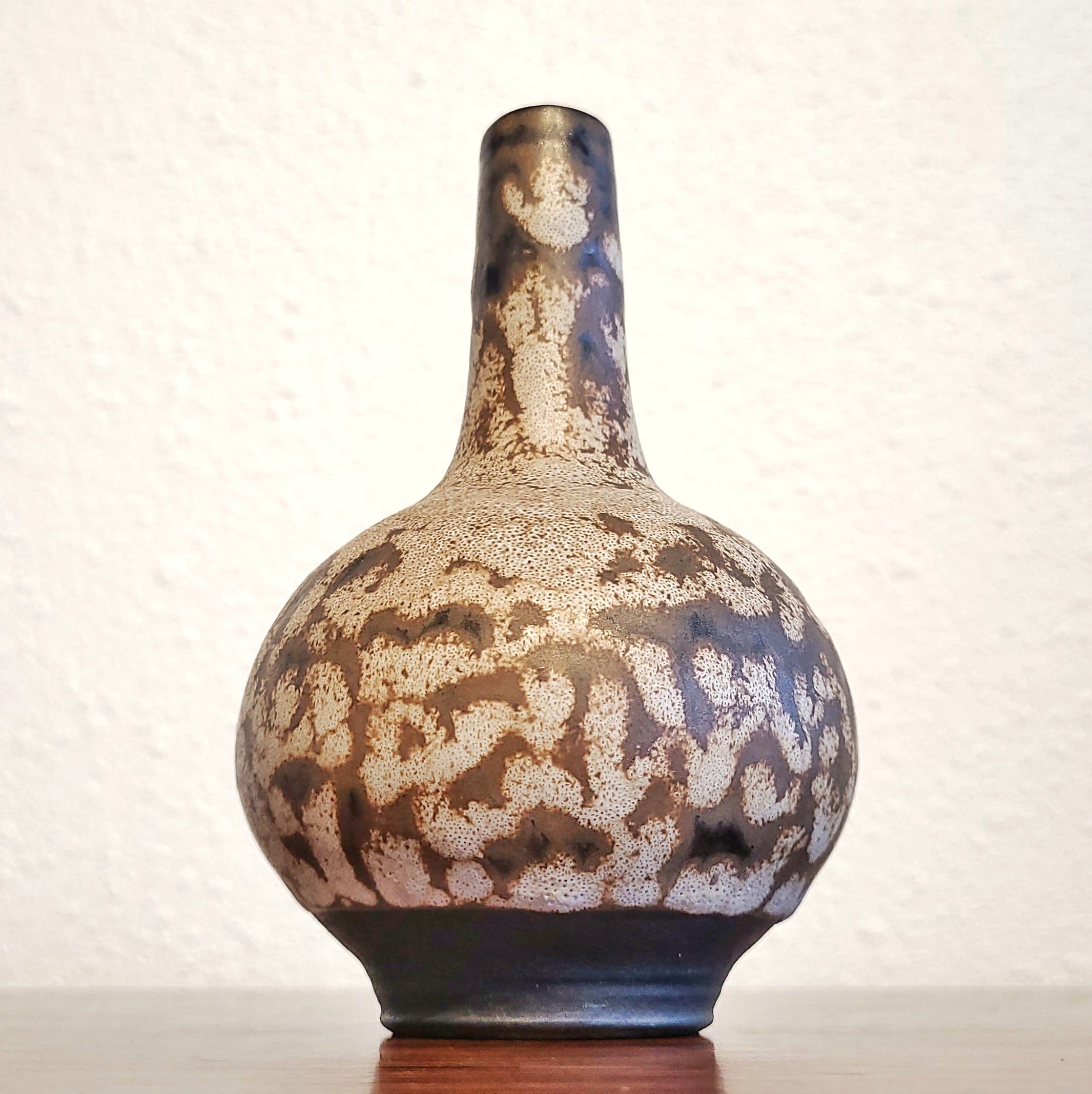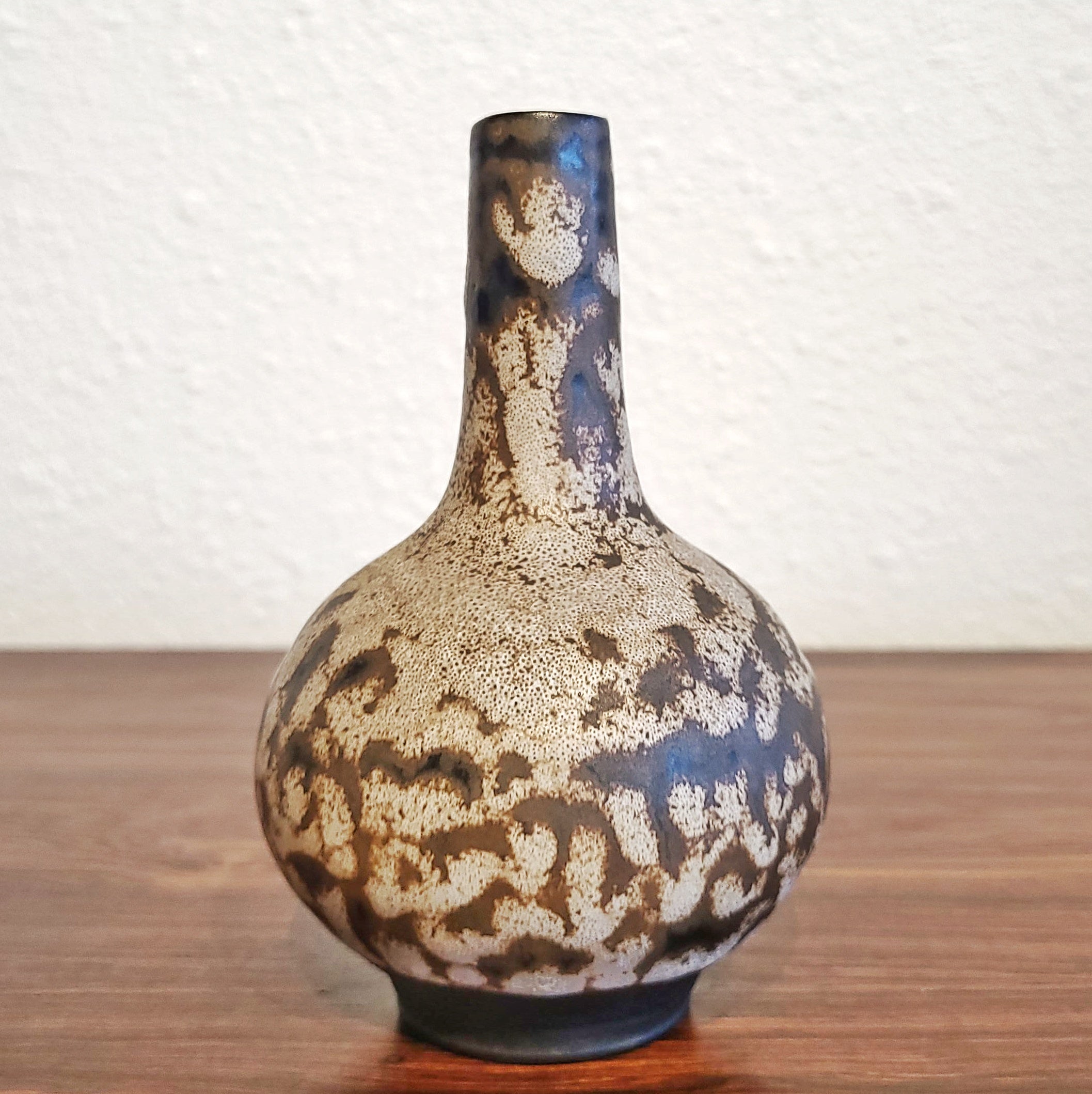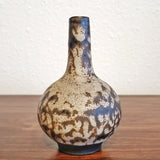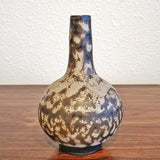








SCHMIDT-TUMMELEY BUD VASE FOR JUIST KERAMIK
CONTACT US HERE ABOUT THIS ITEM.
A very nice bud vase with a bulbous reservoir and a long slender neck designed by Werner Tummeley and Annemarie Schmidt for Juist keramik. The mottled matt glaze in shades of brown and beige cover all but the very bottom of the vase to reveal the dark espresso colored clay from which it was formed.
JUIST is a German barrier island in the North Sea, and also the name of a small pottery workshop that was established there in 1948 by Werner Tummeley and Annemarie Schmidt. Annemarie was born in Cologne in 1919 and Werner in Treis in 1920. Both completed training at the ceramics factory in Höhr-Grenzhausen where they met. While there they were approached by Stephan and Urban Thiersch who were the sons of the Architect Paul Thiersch, the founder of the well-known Burg Giebichenstein School of Applied Arts in Halle, the curriculum of which was based on the Bauhaus model. It was their intention to find a pair of potters to help them create a workshop community of artists at the child sanitarium on Juist Island known as "Der Weberhof". Before the war, they had established a weaving mill there for the therapeutic and financial benefit of the children and were seeking to do the same with a pottery workshop. When selecting suitable employees for the Weberhof workshops, the aim was to give young, enthusiastic artisans a chance, and so it was that in 1947 Annemarie Tummeley and Werner Schmidt came from Höhr-Grenzhausen to join the other artists on the small German barrier island of Juist.
The end of the war, with its tremendous upheavals in all areas of life, was seen by the group of people who started building the Weberhof workshops with the establishment of a company in 1946, as a great opportunity to create a special kind of living and working community not only for joint artistic forms of expression but also to find answers to the vital questions of coping with existence after the total collapse of the state and social order. With the help of diverse relationships and contacts, the company gradually succeeded in procuring important equipment for the Weberhof workshops, such as ceramic and enamel kilns, pottery wheels, workbenches and much more, often using hoarded weaving stocks from the war period as a medium of exchange, since it was not until 1948, after the currency reform on June 20, that cash could be used again. With much determination and the vigor of youth, the couple was able to establish the pottery workshop at the Weberhof in 1948, but in the following year Annemarie and Werner came to the decision to continue their own work independently of the Weberhof. The couple started their own workshop on Juist in 1949 and were married on Christmas day of the same year.
From the start, the focus of their new workshop was on vessel ceramics. Werner took care of the glazes and the technical process, she took care of the molds, the employees and sales. Demand determined which glazes would be pursued and were available for sale. In 1953 Annemarie passed the master craftsman examination. In the following years the couple produced many small batches of ceramic objects as well as many unique items. Even during the boom years for German pottery, the small workshop on Juist Island remained as it was, mostly due to spatial limits, but the demand for and popularity of their work remained strong. Nothing there was ever mass-produced. In addition to participating in several domestic and international exhibitions, they went to the Frankfurt trade fair every winter, and over the years there was usually work for two apprentices and a year-round journeyman. In summer there was usually an intern working for the couple. In 1963, Werner began experimenting with crystalline glazes which resulted in many fine examples and quickly became a favorite among the collectors of their work. The high point in the professional life of the artistically creative couple was the award of the Lower Saxony State Prize for Handicrafts at the end of the 1960s.
Werner Schmidt passed away in 1996. When he died, the boom years were over. In 2009 Annemarie Schmidt handed over the fate of the pottery to the next generation. The couple had two daughters who both became ceramicists. While Andrea turned to Bielefeld and ran a pottery, Nele stayed on Juist and took over the "island pottery" which long ago became part of the fabric of the island. Nevertheless, Annemarie still worked there as long as possible, and at the age of 96 she was still hand painting ceramics. On Friday, December 20, 2019, Annemarie Tummeley-Schmidt celebrated her 100th birthday on Juist Island.
| Designer | SCHMIDT-TUMMELEY |
|---|---|
| Manufacturer | JUIST KERAMIK |
| Design Period | 1960 to 1969 |
| Production Period | 1960 to 1969 |
| Country of Manufacture | Germany |
| Identifying Marks | This piece has an attribution mark |
| Style | Vintage, Mid-Century, Hand-Crafted, Minimalist, Modernist |
| Detailed Condition | Excellent — This vintage piece is in near original condition. It may show minimal traces of use and/or have slight restorations. |
| Product Code | |
| Materials | Ceramic |
| Color | Brown, khaki |
| Width | 3.8 inch |
| Depth | 3.8 inch |
| Height | 6.3 inch |









